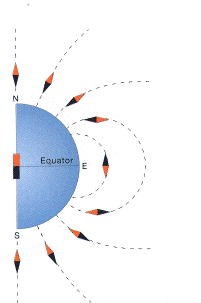

Magnetic lines of force for a simple dipole model of the earth's magnetic field are illustrated above. It is this field that causes the alignment of a compass needle. The origin of the magnetic field is still a question that has not been fully resolved, but many geophysicists believe it is generated as the rotation of the earth causes slow movements in the liquid outer core. The magnetic lines of force resemble those that would be formed if there were an imaginary bar magnet extending through the earth's interior. At the present time, the geomagnetic pole is located 11 degrees of latitude from the rotational axis.

This illustration demonstrates how a suspended compass needle aligns itself in the direction of the earth's magnetic field, this is called inclination. This same magnetic alignment can be found in igneous rocks such as basalt and granite and is called thermoremanent magnetism (TRM). Geologist use this property to determine the paleo-latitudes of continental and oceanic crust at the time of their formation. In virtually all igneous rocks there are varying amounts of the mineral magnetite. When igneous rocks crystallize there temperatures are in excess of 900 degrees Celsius. At these temperatures, the atoms in the minerals have a large amount of energy and are being shaken. The vibrating, shaking atoms are unable to line up until more cooling occurs. At approximately 578 degrees Celsius, the Curie temperature for magnetite, enough energy is lost to allow the atoms to come into alignment with the earth's magnetic field. At tens of degrees below the Curie temperature the blocking temperature is reached and the alignment of the minerals becomes permanent. Another way to understand TRM is to think of the tiny magnetite crystals as compass needles that become frozen in place as the rock cools thus recording the magnetic inclination of the earth's magnetic field at the time of their formation. The Peninsula Ranges Batholith in Southern and Baja California have consistently shown shallow inclinations compared to its present location. A 900 km movement south of its present location would account for these shallow inclinations.
| |||
|
|
|
|
This page hosted by | |||